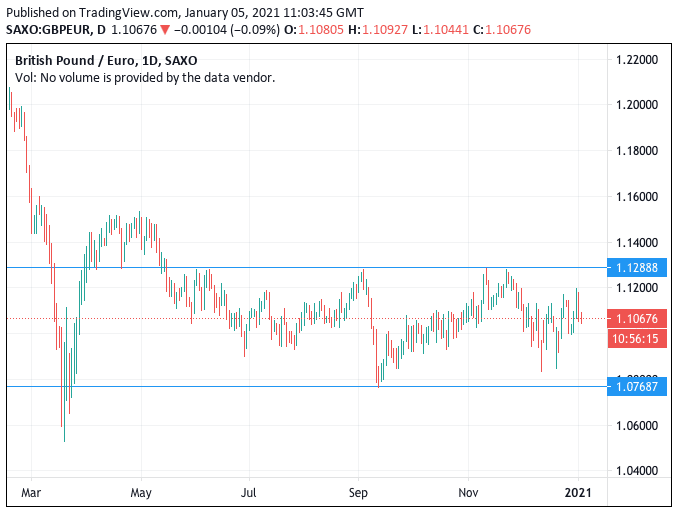Pound-Euro Rate Back Below 1.11, Multi-week Range Likely to Hold

Image © Adobe Images
Secure a retail exchange rate that is between 3-5% stronger than offered by leading banks, learn more.
Pound Sterling fell back towards the middle of a multi-week range as 2021 saw the UK currency trade with a softer tone, courtesy of fading relief over December's EU-UK trade agreement and the announcement of stricter lockdowns in England, Scotland and Northern Ireland.
The decision to further tighten restrictions saw financial markets raise expectations that the Bank of England would soon cut its base interest rate to below 0% in an effort to support a flagging economy.
Economists at Berenberg Bank said the decision to lock England down would see the UK economy shrink by 2.0% in the first quarter of 2021, which when addded to an expected decline of 3.5% for the final quarter of 2020 would make for a technical recession.
Sterling reflected the raised bets for Bank of England rate cuts and economic shrinkage by going lower. The Pound-to-Euro exchange rate fell below 1.11 to quote at 1.1060 at the time of this article's update, meaning the Euro-to-Pound rate rose once more above the technically significant £0.90 level.
"The resurgent pandemic and the subsequent economic restrictions are weighing on the pound. The record-breaking daily infections of Covid-19 in the UK has been met with stricter lockdown measures, hindering economic rebound hopes, and outweighing the relief over the UK-EU trade deal," says George Vessey, Currency Strategist at Western Union.
The declines mean the Pound and Euro continue to trade in what is now becoming a well established range:
Above: GBP/EUR trades in rangebound fashion. For a money tranfer rate just 60 pips away from the market, please see here.
The exchange rate is likely to remain contained by this range for the foreseeable future, and with market focus returning to economic fundamentals the data releases over coming months will become increasingly important.
"Covid-19 is proving a strong headwind to sterling’s uplift and amidst rising risk aversion globally, sterling sentiment is souring," adds Vessey.
The Pound could benefit if the UK government succeeds in rapidly rolling out vaccines, with Prime Minister Boris Johnson vowing to see 2 million people vaccinated a week by the end of January.
Johnson aims to have the most vulnerable sections of society inoculated by the end of February, at which point restrictions can be lifted on a more sustainable basis.
If the Eurozone is unable to match the UK's vaccination agenda then the bloc could be hampered by restrictions for a greater period, which could in turn place upside pressure on the GBP/EUR exchange rate.
"If the new lockdown does work, and more so if vaccine deployment does go quickly from here inwards, sterling could have a good year. In the meantime, it seems clear that a lot of gloom is priced in already," says Kit Juckes, analyst at Société Générale.
{wbamp-hide start}{wbamp-hide end}{wbamp-show start}{wbamp-show end}
Prime Minister Boris Johnson announced a new lockdown effective from Wednesday morning, asking people to remain at home and instructing primary and secondary schools to close.
The impact to economic growth of shutting sizeable parts of the economy once more - including education - is expected to be negative, and the Bank of England could well opt to cut interest rates as soon as their February 04 meeting in an attempt to provide additional support to the economy and financial system.
Interest rates at the Bank are set at a mere 0.10% and Sterling is expected by foreign exchange analysts to fall should market expectations for negative interest rates increase further.
"Q1 GDP is still likely to be very negative as a result of renewed lock-down measures just announced. We are negative GBP short-term and long-term," says Adam Cole, Chief Currency Strategist at RBC Capital.
The closure of schools knocked a significant amount of growth out of the economy in March, when the first lockdown closed educational settings.
"Some BoE MPC members were supportive of a rate cut in December and are certain to become more vocal if the economy is effectively mothballed through another hard lockdown. COVID and exit from the EU mean UK growth will disappoint so if incoming data does not trigger some profit taking in the Pound, the BoE may go down the vocal route of the ECB," says analyst Kenneth Broux at investment bank Société Générale.
The Bank of England has thus far resisted taking interest rates into negative territory, instead opting to wait for politicians to strike a post-Brexit trading deal and for the covid-19 pandemic to run its course while relying on quantitative easing to do most of the heavy lifting on the policy front.
The Bank said in 2020 that it expects to see the economy return to normal by Spring, but these assumptions could be tested by recent developments and market expectations for a cut to negative interest rates by the Bank at some point in 2021 have risen as a result.
The market is now expecting a 0.10% basis cut to have taken place by August.





